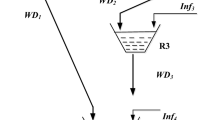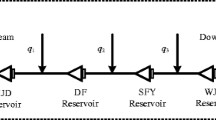Abstract
Slime mould algorithm (SMA) is extensively used in engineering applications such as the parameter estimation of photovoltaic models, image segmentation, economic emission dispatch, etc. To improve SMA’s inherent search stagnation, slow convergence speed and poor transition ability when transferring from exploration to exploitation, especially for optimization problems with high dimensions and many local optimal values, a multi-strategy improved slime mould algorithm (MSMA) is proposed in this paper. The elite chaotic search strategy (ECSS) is adopted to improve the ability of the algorithm to explore near the elite individuals. Moreover, the z parameter of SMA, which originally is a constant, is substituted by a nonlinear convergence factor with chaotic disturbance to enhance the algorithm’s transition ability between exploration and exploitation. MSMA is compared with other 9 classical or advanced metaheuristic algorithms by optimizing 12 benchmark functions, and the comparative results show that MSMA has better performance in solving accuracy, convergence speed and robustness. Finally, to verify the effectiveness of MSMA, MSMA and the other 9 algorithms are applied to a real cascade hydropower reservoirs system along Dadu River in China to maximize the annual power generation. The numerical simulation results show that with the proposed MSMA, the average power generation in the wet year, the normal year and the dry year are 1.11%–19.22%, 0.35%–13.21% and 0.84%–12.85% more than with other algorithms respectively, which verifies the superiority and effectiveness of MSMA for cascade reservoirs operation problem.




Similar content being viewed by others
References
Ahmadianfar I, Noshadian S, Elagib NA, Salarijazi M (2021) Robust diversity-based Sine-Cosine Algorithm for optimizing hydropower multi-reservoir systems. Water Resour Manag 35:3513–3538
Boussaïd I, Lepagnot J, Siarry P (2013) A survey on optimization metaheuristics. Inform Sci 237:82–117
Bozorgi SM, Yazdani S (2019) IWOA: an improved whale optimization algorithm for optimization problems. J Comput Des Eng 6(3):243–259
Chen SR, Wang SY (2020) An optimization method for an integrated energy system scheduling process based on NSGA-II improved by tent mapping chaotic algorithms. Processes 8(4):426
Digalakis JG, Margaritis KG (2001) On benchmarking functions for genetic algorithms. Int J Comput Math 77(4):481–506
Heidari AA, Mirjalili S, Faris H, Aljarah I, Mafarja M, Chen HL (2019) Harris hawks optimization: Algorithm and applications. Future Gener Comp Sy 97:849–872
Houssein EH, Mahdy MA, Blondin MJ, Shebl D, Mohamed WM (2021) Hybrid slime mould algorithm with adaptive guided differential evolution algorithm for combinatorial and global optimization problems. Expert Syst Appl 174:114689
Jamil M, Yang XS (2013) A literature survey of benchmark functions for global optimisation problems. Int J Math Model Numer Optim 4(2):150–194
Karami H, Farzin S, Jahangiri A, Ehteram M, Kisi O, El-Shafie A (2019) Multi-reservoir system optimization based on hybrid gravitational algorithm to minimize water-supply deficiencies. Water Resour Manag 33:2741–2760
Kennedy J, Eberhart R (1995) Particle swarm optimization. In: Proceedings of ICNN’95-international conference on neural networks. IEEE 4:1942–1948
Li SM, Chen HL, Wang MJ, Heidari AA, Mirjalili S (2020) Slime mould algorithm: a new method for stochastic optimization. Future Gener Comp Sy 111:300–323
Liu Y, Heidari AA, Ye XJ, Liang GX, Chen HL, He CT (2021) Boosting slime mould algorithm for parameter identification of photovoltaic models. Energy 234:121164
Mirjalili S (2015) Moth-flame optimization algorithm: a novel nature-inspired heuristic paradigm. Knowl-Based Syst 89:228–249
Mirjalili S, Gandomi AH, Mirjalili SZ, Saremi S, Faris H, Mirjalili SM (2017) Salp Swarm Algorithm: a bio-inspired optimizer for engineering design problems. Adv Eng Softw 114:163–191
Nadimi-Shahraki MH, Taghian S, Mirjalili S (2021) An improved grey wolf optimizer for solving engineering problems. Expert Syst Appl 166:113917
Naik MK, Panda R, Abraham A (2021) Adaptive opposition slime mould algorithm. Soft Comput 25:14297–14313
Niu WJ, Feng ZK, Liu S, Chen YB, Xu YS, Zhang J (2021) Multiple hydropower reservoirs operation by hyperbolic Grey Wolf optimizer based on elitism selection and adaptive mutation. Water Resour Manag 35:573–591
Rahmati K, Ashofteh PS, Loáiciga HA (2021) Application of the Grasshopper Optimization Algorithm (GOA) to the optimal operation of hydropower reservoir systems under climate change. Water Resour Manag 35:4325–4348
Rashedi E, Nezamabadi-Pour H, Saryazdi S (2009) GSA: a gravitational search algorithm. Inform Sci 179(13):2232–2248
Sharifi MR, Akbarifard S, Qaderi K, Madadi MR (2021) Developing MSA algorithm by new fitness-distance-balance selection method to optimize cascade hydropower reservoirs operation. Water Resour Manag 35:385–406
Storn R, Price K (1997) Differential evolution – a simple and efficient heuristic for global optimization over continuous spaces. J Global Optim 11:341–359
Suhail HA, Yang R, Chen HL, Rao G (2020) The impact of river capture on the landscape development of the Dadu River drainage basin, Eastern Tibetan plateau. J Asian Earth Sci 198:104377
Sun KJ, Jia HM, Li Y, Jiang ZC (2021) Hybrid improved slime mould algorithm with adaptive β hill climbing for numerical optimization. J Intell Fuzzy Syst 40(1):1667–1679
Wolpert DH, Macready WG (1997) No free lunch theorems for optimization. IEEE T Evolut Comput 1(1):67–82
Wu Y, Wang WS, Wang GQ (2016) Detecting variation trends of temperature and precipitation for the Dadu River Basin. China Adv Meteorol 2016:2564586
Xiang T, Liao X, Wong KW (2007) An improved particle swarm optimization algorithm combined with piecewise linear chaotic map. Appl Math Comput 190(2):1637–1645
Yu CY, Heidari AA, Xue X, Zhang LJ, Chen H, Chen WB (2021a) Boosting quantum rotation gate embedded slime mould algorithm. Expert Syst Appl 181:115082
Yu L, Wu XF, Wu SQ, Jia BY, Han GY, Xu P, Dai JY, Zhang Y, Wang FF, Yang QQ, Zhou ZH (2021b) Multi-objective optimal operation of cascade hydropower plants considering ecological flow under different ecological conditions. J Hydrol 601:126599
Zarei A, Mousavi SF, Gordji ME, Karami H (2019) Optimal reservoir operation using bat and particle swarm algorithm and game theory based on optimal water allocation among consumers. Water Resour Manag 33:3071–3093
Zhao SW, Wang PJ, Heidari AA, Chen HL, Turabieh H, Mafarja M, Li CY (2021) Multilevel threshold image segmentation with diffusion association slime mould algorithm and Renyi’s entropy for chronic obstructive pulmonary disease. Comput Biol Med 134:104427
Funding
This work is supported by the Science & Technology Department of Sichuan Province (2021YFG0218), Science & Technology Department of Chengdu City (2021-YF05-01358-SN).
Author information
Authors and Affiliations
Contributions
H M: Supervision, Review, English editing, Funding acquisition. ZR Q: Data collection, Programming, Analysis, Writing. CB Z: Material preparation, Methodology, Funding acquisition.
Corresponding author
Ethics declarations
Ethics Approval
All authors kept the ethical standards.
Consent to Participate
All of the authors declare their consent to participate in this work.
Consent to Publish
All of the authors declare their consent to publication of this manuscript.
Competing Interests
The authors have no relevant financial or non-financial interests to disclose.
Additional information
Publisher's Note
Springer Nature remains neutral with regard to jurisdictional claims in published maps and institutional affiliations.
Rights and permissions
About this article
Cite this article
Miao, H., Qiu, Z. & Zeng, C. Multi-Strategy Improved Slime Mould Algorithm and its Application in Optimal Operation of Cascade Reservoirs. Water Resour Manage 36, 3029–3048 (2022). https://doi.org/10.1007/s11269-022-03183-4
Received:
Accepted:
Published:
Issue Date:
DOI: https://doi.org/10.1007/s11269-022-03183-4




